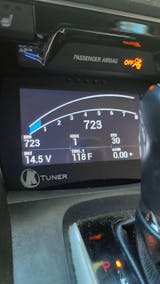
Most people view their cars as a tool that simply gets them from one place to another. However, the mechanisms inside the engine of a car are complex and fascinating. Have you ever thought of how it actually works? Are there ways to improve how well it works? If you are curious about your car engine and how to upgrade it, then understanding some basics of the internal combustion engine is key.
How does a car engine work?
Whenever gasoline burns, an internal combustion engine converts the heat energy produced to mechanical energy, also known as torque. The torque is then applied to the wheels for your car to move. Whether you are driving an ancient car or a modern car, both of the cars' engines rely on the same principles.
Inside the engine, pistons are housed in metal tubes called cylinders. The up and down movement of pistons inside these cylinders is what spins the crankshaft to power your car's wheels. You can compare this to riding a bicycle: the similar up and down leg movement spins a bike's wheels.
The number of cylinders in an engine ranges between 2 and 10, depending on the type of vehicle. Most cars have 4 or 6 cylinders, while trucks usually have 6 or 8. Each cylinder has its own piston moving up and down.
So, what enables the pistons inside the cylinders to move up and down? The pistons are powered by controlled chemical reactions that are created every time combustion (the ignition of fuel) takes place. Oxygen must be present for fuel ignition to occur.
Most vehicles have internal combustion engines that have a four-stroke process: intake, compression, power, and exhaust. In this process, the piston starts at the top of the cylinder. As it moves down, the intake valve opens and the air and fuel are drawn into the combustion chamber. The piston reaches the bottom of the cylinder; then as it travels back up, the intake valve will close to seal the cylinder and compress the air and fuel mixture. As the piston reaches the top, the spark plug fires.
The air and fuel mixture burns, which increases pressure in the cylinder and forces the piston back down the cylinder. The exhaust valve opens and the piston pushes out the burned gases, then the exhaust valve closes back up and the cycle begins again.
Modifying Car Engines

Most car enthusiasts love to improve the performance of their vehicles by modifying their engines to make them more fuel-efficient. Simply increasing the amount of fuel in the engine is not effective because of the poor oxygen and combustion fuel relationship. So, you must modify the engine to accommodate more oxygen and fuel. For that to happen, you need to modify your car:
Superchargers
Superchargers accelerate the entry of more air into the engine, usually above the normal atmospheric level, to mix with more fuel for more power. A belt from the crankshaft powers the supercharger mechanically to enable it to spin at a rate of over 50,000 RPM, forcing more air into the combustion chamber. More space is created for fuel to create immense combustion.
As a result of this, 30 to 50 percent more horsepower is created with the correct installation of everything in the engine combustion chamber. A moderate-sized vehicle will be more powerful if you attach a supercharger to the engine. Once you've read the manufacturer's instructions, bolting it into the engine will be a simple task.
Turbochargers
Just like the supercharger, the turbocharger also helps to increase the car's horsepower. It depends on the exhaust from the vehicle which spools a turbine to power a compressor. The "pulling in" action of the compressor increases the entry of air into the engine.
Difference between superchargers and turbochargers
-
A supercharger relies on the engine to rotate, while a turbocharger relies on the vehicle's exhaust and turns it into something useful.
-
Turbochargers require engine oil for lubrication.
-
Turbochargers are found more often on mainstream vehicles, while superchargers tend to be seen in high-performance vehicles.
Air Filters

With time, contaminants and impurities fill your car which reduces its efficiency. Upgrading your car’s air filters will improve its performance by enabling the entry of more air for more efficient combustion. Made of a thin layer of cotton, the air filters help block contaminants. They are easy to install and washable, offering an affordable long-term performance boost for your vehicle.
Cold Air Intake Kit
Cold air intake kits are one of the easier and more inexpensive ways to upgrade your car’s engine. Though seemingly minor, air temperature can affect your car's horsepower. Therefore, it's critical to regulate the temperature of the air entering the engine. A cold air intake kit is a system that you can install to ensure that cooler air is being sucked into the engine. This cooler air contains more oxygen, which is important for effective combustion. Cold air intakes also increase airflow to the engine, leading to higher engine efficiency and increased performance.
Performance Chips
Modern cars have onboard computers that help in controlling different functions such as fuel-to-air ratio, anti-lock brakes, and timing. Performance chips can be installed as hacks that interrupt factory settings to increase horsepower. They will set new parameters on the operations chosen including commanding your car to use fuel efficiently, or take in more air for ignition.
If you familiarize yourself with your car’s electronic system, the chips are easy to install; it is as simple as plugging a chip into a computer.
Weight Reduction
According to basic dynamics, lighter objects move easier than heavier objects. Therefore, it makes sense to reduce the weight of your vehicle so that the engine can work more efficiently. While this modification is low-tech and easy to implement, you do have to put in some hard work. It involves removing heavier parts of the car and replacing them with lighter ones to make the car more lighter and more aerodynamic. There are tons of ways to get started, such as replacing your glass windows with plastic versions, replacing traditional brakes with disc brakes, removing unnecessary seats, switching to lighter tires, and many other options.
ECU
Tuning your Engine Control Unit (ECU) is an aftermarket solution that helps to boost engine performance by modifying the fuel and spark maps of your engine. Many times, the factory parameters are shy of the engine’s full capabilities for general safety reasons. One way to tune the ECU is by adjusting the air-fuel ratio. Increasing the fuel can maximize the engine power, and in turn can improve its performance. Getting the ratio just right can be tricky, so seek a professional’s advice if you have any questions.
You can also optimize the ignition timing by changing when the spark plugs fire during the compression stroke. Advancing the timing, or modifying it so that the plugs fire sooner, can maximize the amount of power. However, messing with the ignition timing can cause engine knocking, overheating, or other damage if not done correctly. Again, consult a professional if you have any concerns.
Exhaust Systems

The exhaust system can be of the more expensive parts to modify, but it is of great significance to the effectiveness of your car. In fact, vehicles usually report a 5% improvement in fuel economy after an exhaust system upgrade. It all starts at the cylinder head, from where each component is tailored to work with each other. A basic understanding of how it works will help you to know what takes place the moment burned gases escape from the engine. The exhaust systems enhance the smooth flow and high velocities of gases leaving the engine. It's the reason why porting should be done to avoid disrupting the dynamic flow of the engineered fluid. Once the exhaust valve opens and is enhanced by the upward movement of the piston, hot gases leave the exhaust port at high speed.
Spark Plugs

Although often forgotten, these tiny parts have a crucial role in the functioning of your vehicle. If your spark plugs aren’t properly operating, your car won't be able to move. They work by producing a spark of electricity necessary for starting your car. These tiny bolts are resistant to extreme temperatures and pressure within the engine's cylinders.
Keep in mind that the pistons of your car need to be put in motion to improve the horsepower of your car, and to help burn the compressed air-fuel mixture smoothly. For that to happen you need to regularly check the health status of your spark plugs. Poor or weak spark plugs lead to cold-starting issues or misfiring during acceleration, reduced horsepower, and poor fuel economy.
Once you have installed an extremely durable quality spark plug, they can serve you for a long time and many miles without replacing them. There are several types of spark plugs, and the best fit depends on your car.
-
Copper: Copper spark plugs have high conductivity, and some high performance vehicles require this type. However, they tend to have a shorter lifespan as the result of their softer nickel alloy electrode.
-
Platinum/Double Platinum: These sparks last longer than copper as they are made from platinum. They also run hotter which helps to prevent deposit buildup. Double platinum spark plugs may be recommended to ensure a longer lifespan and better performance in certain cars.
-
Iridium/Double Iridium: Iridium spark plugs are the hardest and strongest type. They are more expensive, but they can increase the firing efficiency.
To determine the best type for your car, check your vehicle’s manual or consult a local mechanic. Never downgrade; if your manual calls for iridium spark plugs, choosing copper spark plugs can result in poor engine performance. Most manufacturers recommend spark plug installation after every 30,000 miles. However, their lifespan and efficiency will depend on the type and condition.
Benefits of Replacing Spark Plugs
New spark plugs provide more than just starting the car without any issues. Other performance benefits include:
-
Optimal combustion: A new spark plug can fix your car performance issues.
-
Better fuel economy: Good quality and healthy plugs can help optimize fuel economy.
-
Smooth and powerful starts with no misfiring.
-
Fewer emissions: Regular engine tune-ups often lead to less harmful emissions.
Spoilers
To better understand the function of spoilers on a vehicle, visualize a high speed moving car. When you're driving, the air the vehicle moves through flows over the top and under the car. The force created below the car will try to push it up, making it extremely difficult for tires to hold up the track as it normally would. The resulting wind and air resistance will decrease the car speed, resulting in the engine having to work hard to move the car forward.
Spoilers are installed to “spoil” the airflow and reduce drag. The addition of other aerodynamic features including rear wing and side skirts can also increase speed while maintaining great control over the car, even when approaching sharp corners.
Front spoilers
Front spoilers can be attached to or installed under a car's front bumper. Not only do front spoilers redirect the airflow to cool the engine chamber, but they also displace the air under the vehicle away from the tires. Moreover, front spoilers help reduce drag and lift, as well as dispelling air before it finds its way to the rear spoiler. While their main purpose is to reduce fuel costs, they are beneficial in increasing the speed and efficiency of your car.
Things to Remember
Various modifications to your vehicle are essential to achieving its maximum capabilities: improved speed with greater control, increased horsepower, improved engine combustion, effective and efficient air-fuel ignition, and powerful starts.
However, before you decide to tune-up your car you should consider a few things:
- Safety
Car modification can be a complex process. It takes more than a few prior mechanical skills to make changes to the engine and other critical parts of your car. If you feel you can manage to modify the car by yourself, ensure to wear appropriate protective gear such as gloves and safety glasses. Stay protected from dangerous exposed wires, batteries, and sharp objects.
- Professional Advice
Many of these modifications may sound easy, even for beginners. However, because it can involve modifying the most critical parts of your vehicle, you should seek professional advice beforehand. For example, remapping your ECU parameters on your own might seem easy at first, but even one mistake can cost you tons of time, and sometimes even money, to fix. If you do decide to consult a professional, check their credentials and make sure they are qualified.
- Abiding by Your Warranty
Your car warranty is a contract between you and an insurer, to help you make some repairs as long as you keep your car in good condition. Some of the repairs and modifications you make can force your insurer to void the warranty. It is necessary for you to do some research to prepare yourself for any future implications.
These are just some of the ways you can modify your car engine, but you can always keep improving. If you are informed and prepared, you can greatly increase the amount of power and efficiency you get out of your engine with just a few steps - and have fun in the process.











